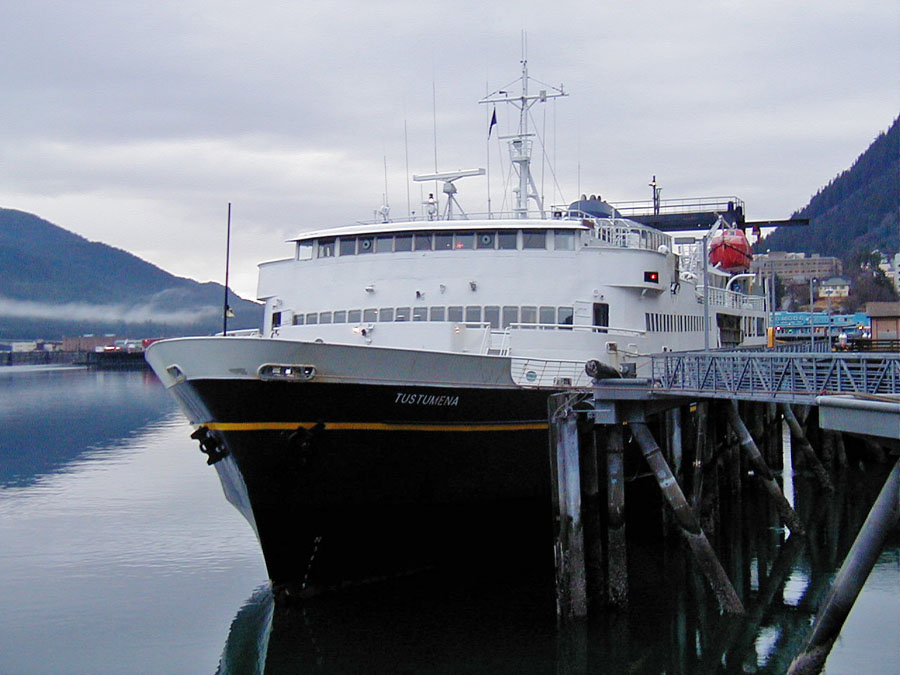
As the Alaska Marine Highway System approaches its 50th anniversary, the ferry is struggling with its identity. Under intense pressure to cut costs, the ferry’s managers are trying to get back to basics — transporting Alaskans and their freight.
That’s why the state is trying to phase out wildlife naturalists, on all ferry routes. It’s not clear what that means for riders.
It takes the Tustumena three and a half days to sail from Homer to Unalaska. Along the way, passengers will see kittiwakes and puffins, orcas and foxes.
The route has been named a national scenic byway, but the volcanic terrain can be foreign to both for lifelong Alaskans, and visitors passing through from the Lower 48.
That’s why naturalists, like Doug Stuart, travel on the ferry. Stuart says he’s there to provide context for the scenery:
“Of course, we give a lot of informational programs, and cover everything that goes on in the Aleutians — from World War II to the seabirds and marine mammals, and cultural issues with the Native Unangan people that have populated the Aleutians for 9,000 years.”
The Fish and Wildlife Service has employed Stuart as the Tustumena’s naturalist for more than a decade. But he won’t be on the ferry this summer.
The ferry system has given a lot of different reasons for wanting to eliminate the program. One is federal budget cuts.
Federal money covers the naturalists’ salaries. Poppy Benson, who administers the program for the Alaska Maritime National Wildlife Refuge in Homer, says money was tight for the program this year, but she managed to scrape it together by asking other refuges to chip in.
Benson: “So between Izembek National Wildlife Refuge in Cold Bay and Kodiak National Wildlife Refuge, and Alaska Maritime, I came up with enough money to fund a season.”
Woodrow: “We were surprised to even see that they had the funding for an interpreter.”
That’s Jeremy Woodrow, a spokesman for the Alaska Department of Transportation. According to Woodrow, the state wasn’t expecting the refuges to come up with the money with the federal sequester in place.
Benson says the wildlife refuges thought it was just a misunderstanding — but it isn’t. As Woodrow puts it, the State of Alaska has decided that the space the naturalists take up should be sold to residents instead:
“It all comes down to cost. And does it help meet our core mission, which is to help move people between points A and B.”
On the Tustumena, naturalists get free room and board from the ferry system. For an entire summer, that’s about $5,000 worth of support.
But Woodrow says it’s not just about the price tag. The state isn’t convinced that the naturalists bring any business to the ferry system:
“From a marketing standpoint, the Marine Highway System doesn’t see an actual –- I don’t want to say a benefit, but doesn’t see that having an interpreter on board will help fill seats more, especially with the Tustumena where it’s sold out anyways.”
Staterooms on the Tustumena are already selling out for the summer run. But according to Stuart, the Tustumena naturalist, it’s not just residents buying those rooms:
“Quite a few people ride that ship as tourists! I would say by the time we’re out of Kodiak, we’re probably roughly 50/50 tourists and then the other 50% a mix of commercial fishermen and residents. So it’s a pretty big ridership.”
It’s gotten bigger, in recent years. Frommer’s, the famed guidebook, listed the state ferry as one of the top 100 attractions in America for families with kids. One of the big draws? The naturalists.
Stuart says he was always a big hit with tourists. But the naturalists weren’t all about serving visitors. As the ferry progressed on its trip, Stuart says naturalists made an effort to keep all of the passengers in the loop — even if they were locals:
“It’s a very interesting area, but without having anybody explaining it to the people on board, frankly, they don’t have a clue what’s going on out there — particularly if the weather gets bad. Onboard programming, and having that information flow from me to the passengers, is important.”
To replace that, the Department of Transportation is considering adding interpretive displays, or interactive exhibits. They aren’t sure exactly what it will look like, and it likely won’t be in place in time for the ferry’s 50th anniversary this summer.
The Alaska Marine Highway System is planning a celebration, with community festivals throughout southeast and southcentral Alaska.
Stuart was planning events for southwest Alaska on the Tustumena, before he found out the naturalist program was canceled. With no one on board to help the Tustumena celebrate, the anniversary sailings in through southwest Alaska might look a lot like the ferry’s future, in all state waters.
